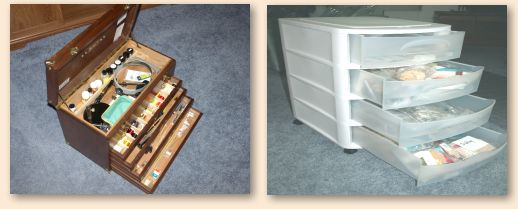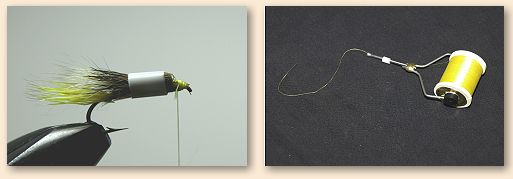Anyone who has been tying for a while gradually picks
up tips and tricks to make your tying easier. Many of
these tips you collect from what other tyers have written
or shared with you. Others you develop yourself, by
accident or out of necessity.
Many of the tips I'm about to share with you are not
necessarily my own. And regretfully I don't know who
originally developed them, so that I can give them the
appropriate acknowledgement in this article — for
that I am truly sorry. Many of the others are my own.
But whether or not the tips are mine or someone else's,
it has been my experience that fly tyers everywhere enjoy
sharing. I hope you find these tips helpful.
Organization
- Dedicate a small area in your home where you can
store your equipment and tie flies. This sure beats going
looking for everything each time you want to do some
tying.
- As money permits, purchase or build a tying chest
for the storage of tools, threads and materials. Once
organized, you'll know right where everything is; you'll know
what you have on hand and what you need to order.
- Consider a cedar lined storage chest. This will prevent
an invasion of insect pest.
- Check out your local general merchandise stores (K-Mart,
Wal-Mart, etc), they have a good selections of large and
small plastic storage containers.

Tools
- Use pipe cleaners to clean out you bobbins.
- Egg cartons have many uses, storage of flies,
dispensing dubbing and as many other uses as your brain
can think of.
- Save old tooth brushes and combs, they're great for combing out under hairs and
for that final groomed look on flies.
- Check with your local jeweler — purchase from him/her a pair of fine point
jeweler's tweezers. They're great for plucking out 'individual hairs' on your
presentation flies.
- Soda straws (in multiple sizes) work as the best hackle guards I've even seen.
I keep it right on my bobbin — then just slide it onto the hook and push all the
materials back so that I can tie off the head.

Materials
- Use small film canisters or old pill bottles, with holes punched in the top. Add
moth balls or whole cloves to the containers to keep insects out of your
natural materials. Cedar wood works well also, just keep it sanded every couple of
years to refresh the cedar smell.
- Use electrical tape to seal all of your fly tying fluid bottles — thus preventing
evaporation and thickening.
- Head cement can be thinned using denatured alcohol.
- Another way to protect your fly tying materials from insect invasion is by
sealing your materials in plastic zip lock bags.
Tying
- Use permanent markers to color bleached quills.
- Need fly tying lacquer — use straight hair
spray —remove the pump sprayer and dip in a paint brush.
- Use Kool Aid for dying materials.
- Soak quills in cooking oil prior to wrapping them (or
glycerin and water solution) — it keeps them from
splitting when you wrap them.
- Stripping quills? Three things you can do; use bleach
— works great — but it only takes a few seconds,
so pay attention. Second method, use a pencil eraser. Third
method, run your quill through the eye of a hook — strips
it right off.
- The use of a depilatory (hair removal cream) has also
been suggested for stripping quills.
- Use Chap-Stick as a dubbing wax.
- Use clear nail polish as a lacquer.
- Use colored nail polishes as a lacquer for the heads
on your flies.
- Perfect wings every time! Cut your wings to shape,
then apply 'flexament' to both sides and allow to dry before
tying them on to your fly.
- Lacquer your tails and bodies — before
tying on you wings.
General
- Get you spouse involved in fly tying. It will give you
something you can both do together. The greatest thing you'll even do!
- Visit sewing and fabric stores for threads, needles,
and other materials.
- All thumbs on the water —try tying your knots
using hemostats, instead of your fingers.
- Old, limp, tired flies can be revived by steaming them.
I use a tea kettle, and use forceps to hold the fly into the steam.
See you on the water… ~ Tom Deschaine
Please check out the Fly Tying Section, on the Bulletin Board here at FAOL too.
If you have any questions, tips, or techniques; send them to
publisher@flyanglersonline.com
|


